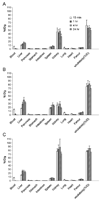New nanosized biocompatible MR contrast agents based on lysine-dendri-graft macromolecules
- PMID: 20235572
- PMCID: PMC2884170
- DOI: 10.1021/bc9005442
New nanosized biocompatible MR contrast agents based on lysine-dendri-graft macromolecules
Abstract
Paramagnetic nanomaterials for use as magnetic resonance imaging (MRI) contrast agents have higher relaxivity than conventional low molecular weight MRI agents. However, the biocompatibility and pharmacokinetics of such nanomaterials will strongly affect the likelihood of clinical approval. We synthesized MRI contrast agents based on biocompatible lysine-dendri-grafts: Gd-BzDTPA-lysineG2 and Gd-BzDTPA-lysineG3. The relaxivity of Gd-BzDTPA-lysineG2 and Gd-BzDTPA-lysineG3 increased with sample temperature, while the relaxivity of Gd-BzDTPA-PAMAMG4 decreased with increasing sample temperature. The increase in relaxivity with increasing temperature may be attributed to accessibility of water to the internal Gd chelates with lysine-dendri-grafts, which does not occur with PAMAM dendrimers. Gd-BzDTPA-lysineG3 had a long intravascular half-life but were largely excreted by the kidneys. Therefore, Gd-BzDTPA-lysineG3 enhanced the blood vessels for longer periods than Gd-BzDTPA-PAMAMG4, but was still excreted through the kidney. Because of their biocompatibility, desirable magneto-physical characteristics and favorable pharmacokinetics, which are derived from different interior structures rather than the physical size, lysine-dendri-graft MR contrast agents may be feasible for clinical use.
Figures






Similar articles
-
Gadolinium MRI contrast agents based on triazine dendrimers: relaxivity and in vivo pharmacokinetics.Bioconjug Chem. 2012 Nov 21;23(11):2291-9. doi: 10.1021/bc300461r. Epub 2012 Oct 22. Bioconjug Chem. 2012. PMID: 23035964 Free PMC article.
-
Dendrimer-based MRI contrast agents: the effects of PEGylation on relaxivity and pharmacokinetics.Nanomedicine. 2011 Dec;7(6):1001-8. doi: 10.1016/j.nano.2011.03.007. Epub 2011 Apr 8. Nanomedicine. 2011. PMID: 21515406 Free PMC article.
-
Macromolecular MRI contrast agents with small dendrimers: pharmacokinetic differences between sizes and cores.Bioconjug Chem. 2003 Mar-Apr;14(2):388-94. doi: 10.1021/bc025633c. Bioconjug Chem. 2003. PMID: 12643749
-
Polyion complex micelles of poly(ethylene glycol)-b-poly(L-lysine)-gadolinium-1,4,7,10-tetraazacyclododecane-1,4,7,10-tetraacetic acid-dextran sulfate.2011 May 31 [updated 2011 Jun 23]. In: Molecular Imaging and Contrast Agent Database (MICAD) [Internet]. Bethesda (MD): National Center for Biotechnology Information (US); 2004–2013. 2011 May 31 [updated 2011 Jun 23]. In: Molecular Imaging and Contrast Agent Database (MICAD) [Internet]. Bethesda (MD): National Center for Biotechnology Information (US); 2004–2013. PMID: 21735585 Free Books & Documents. Review.
-
Poly(ethylene glycol)-b-poly(L-lysine)-gadolinium-1,4,7,10-tetraazacyclododecane-1,4,7,10-tetraacetic acid micelle.2011 May 31 [updated 2011 Jun 23]. In: Molecular Imaging and Contrast Agent Database (MICAD) [Internet]. Bethesda (MD): National Center for Biotechnology Information (US); 2004–2013. 2011 May 31 [updated 2011 Jun 23]. In: Molecular Imaging and Contrast Agent Database (MICAD) [Internet]. Bethesda (MD): National Center for Biotechnology Information (US); 2004–2013. PMID: 21735590 Free Books & Documents. Review.
Cited by
-
Highly Branched Polymers Based on Poly(amino acid)s for Biomedical Application.Nanomaterials (Basel). 2021 Apr 26;11(5):1119. doi: 10.3390/nano11051119. Nanomaterials (Basel). 2021. PMID: 33925961 Free PMC article. Review.
-
Molecular Dynamics of Lysine Dendrigrafts in Methanol-Water Mixtures.Int J Mol Sci. 2023 Feb 4;24(4):3063. doi: 10.3390/ijms24043063. Int J Mol Sci. 2023. PMID: 36834474 Free PMC article.
-
Inorganic Nanomaterial-Mediated Gene Therapy in Combination with Other Antitumor Treatment Modalities.Adv Funct Mater. 2021 Jan 27;31(5):2007096. doi: 10.1002/adfm.202007096. Epub 2020 Oct 13. Adv Funct Mater. 2021. PMID: 34366761 Free PMC article.
-
Silencing the roadblocks to effective triple-negative breast cancer treatments by siRNA nanoparticles.Endocr Relat Cancer. 2017 Apr;24(4):R81-R97. doi: 10.1530/ERC-16-0482. Epub 2017 Feb 1. Endocr Relat Cancer. 2017. PMID: 28148541 Free PMC article. Review.
-
Control of polymeric nanoparticle size to improve therapeutic delivery.J Control Release. 2015 Dec 10;219:536-547. doi: 10.1016/j.jconrel.2015.10.006. Epub 2015 Oct 9. J Control Release. 2015. PMID: 26450667 Free PMC article. Review.
References
-
- Kobayashi H, Brechbiel MW. Nano-sized MRI contrast agents with dendrimer cores. Adv Drug Deliv Rev. 2005;57:2271–2286. - PubMed
-
- Kobayashi H, Brechbiel MW. Dendrimer-based macromolecular MRI contrast agents: characteristics and application. Mol Imaging. 2003;2:1–10. - PubMed
-
- Bawarski WE, Chidlowsky E, Bharali DJ, Mousa SA. Emerging nanopharmaceuticals. Nanomedicine. 2008;4:273–282. - PubMed
-
- Helms B, Meijer EW. Chemistry. Dendrimers at work. Science. 2006;313:929–930. - PubMed
-
- Thierry B. Drug nanocarriers and functional nanoparticles: applications in cancer therapy. Curr Drug Deliv. 2009;6:391–403. - PubMed
Publication types
MeSH terms
Substances
Grants and funding
LinkOut - more resources
Full Text Sources
Other Literature Sources
Medical

